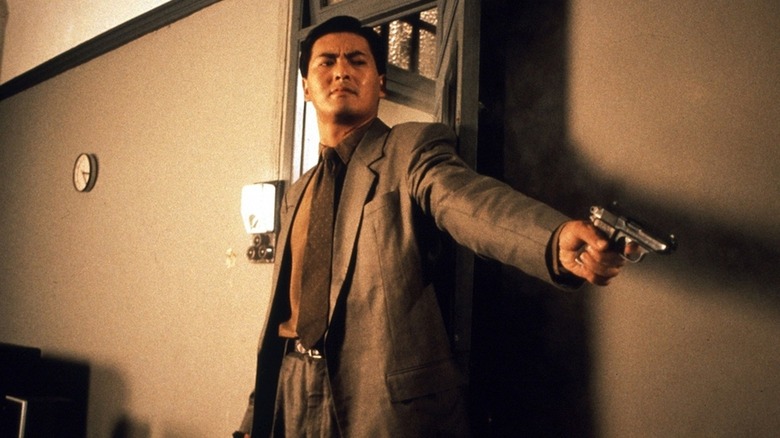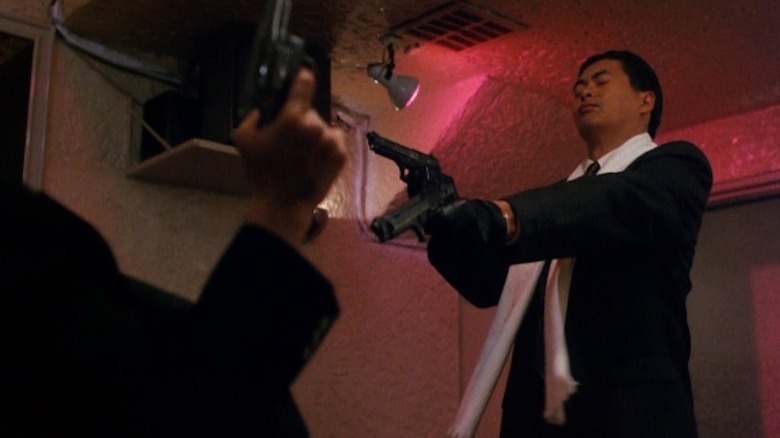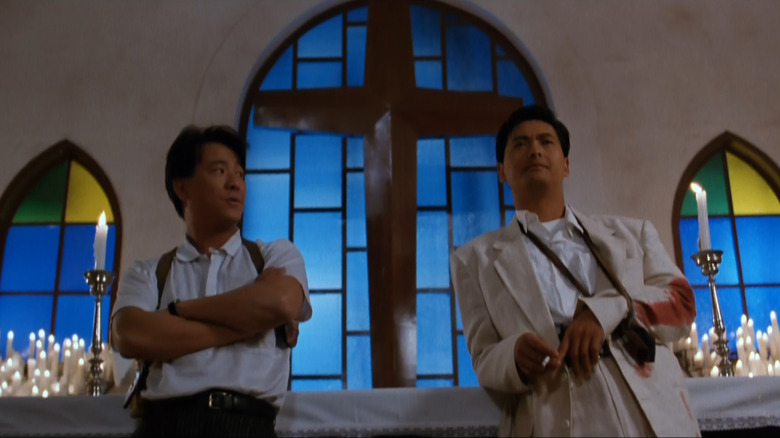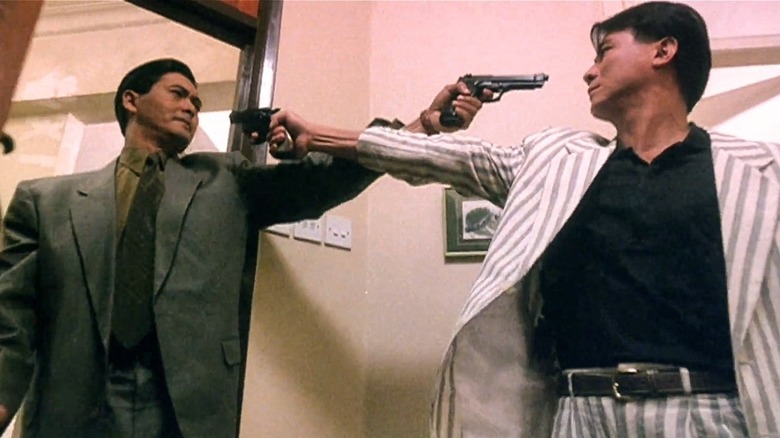These Filmmakers Influenced John Woo's Directorial Style
1991 was a watershed year for action movies the world over. In terms of immediate impact, nothing could rival "Terminator 2: Judgment Day." James Cameron's blockbuster sequel to his sci-fi sleeper hit dazzled audiences with its state-of-the-art morphing effects (already lightyears ahead of the "water tentacle" introduced in "The Abyss" just two years earlier), and set the bar so dizzyingly high on practically staged action that directors had to tip their caps and leave the going-bigger part of the filmmaking equation to the only person who could afford to go bigger.
Far more fascinating from a longterm trend perspective was the American film industry's acknowledgment of its chief cultural import's growing impact on international action cinema. Luc Besson's trash-art smash "La Femme Nikita," starring punky Anne Parillaud as a sexy and plenty ruthless assassin, racked up a tidy $5 million in U.S. theaters, sparking Hollywood's renewed interest in building action franchises around female characters. Though it'd take a while for the studios to crack that particular formula, Besson's mixture of perfume-ad sensuality and sleek bloodletting went down smooth for an industry that had just anointed Tony Scott as one of its action gods.
But what was happening in Hong Kong with this upstart fella named John Woo, whose 1989 salvo "The Killer" had been playing to raves at major film festivals for a solid year, truly confounded the studios. When the movie hit U.S. art houses, American cinephiles began hailing Woo as the greatest action director on the planet, primarily because he'd taken a quintessential Hollywood genre, and one-upped its current practitioners in every way. By absorbing Hollywood past (and some of its present), Woo had become the industry's future. And he did it standing on the shoulders of some of its finest filmmakers.
The birth of Gun-Fu
To be clear, Woo's filmmaking aesthetic is a fusion of Eastern and Western sensibilities. Though the decade he spent churning out martial arts flicks for Hong Kong's Golden Harvest production company was not a happy one, his experience inspired him to transpose the kinetic, kung-fu combat style to the stale, convention-bound milieu of the shootout.
Take a look at the opening nightclub scene of "The Killer" (as, I guarantee you, every action director worth their weight in squibs has since the film was released). Here you have Chow Yun-Fat assuming the obligatory one-man-army role of Bruce Lee or Jackie Chan as he dispatches an establishment full of goons, all of whom attack one, maybe two at a time to give our hero room to operate (viewers who groan at such accommodating tactics have hopefully long since moved on to rigidly naturalistic cinema and documentaries). At the outset of the battle, Chow dives backward into the body of a henchman he's just dispatched, thus flinging himself the threshold of a room filled with gun-toting thugs. This balletic move allows him to pick off two heavies posted at either side of the door, after which he springs up, clips another to his left and gets the drop on his primary target, commencing a standoff that lasts all of a second before Chow pops one in the man's cooler.
As the gunplay continues, Chow cleverly improvises to maintain his advantage (e.g. upending a poker table to fling himself a stray pistol as a hoodlum takes dead aim). This is classic martial arts choreography turned twice as lethal with the addition of firearms. Action-wise, this is the most prominent Eastern element of Woo's style.
The First United Church of Peckinpah and Scorsese
When Westerners first caught a gander of Woo via "The Killer," they led with the obvious comparisons, Sam Peckinpah and Martin Scorsese, and rightfully so. The Peckinpah influence is most pronounced. Woo wasn't the first director to ape the elegiac auteur's penchant for punctuating his shootouts with perversely beautiful slow-motion grace notes (Brian De Palma overcranked with giddy abandon starting in the '70s, while Peckinpah protege Walter Hill was on this as early as "The Warriors"), but that nightclub sequence in "The Killer" was the first time the technique felt truly reinvigorated. The quick, skillful cutting is always in rhythm. Woo knows precisely when to go slow, and where to ramp it back up to achieve maximum viewer exhilaration. Nothing new there. But the moment where Chow blinds Sally Yeh's caught-in-the-crossfire chanteuse with a muzzle flash from his pistol, Woo decelerates to rub our noses in the unnecessary anguish wrought by violent men and their guns. This is when "The Killer" tilts full-on Sirkian melodrama. This is when it becomes, per film critic J. Hoberman, "'Magnificent Obsession' remade by Sam Peckinpah."
The Scorsese influence on "The Killer" is more thematic. When Chow's conscience is pricked by his unintentional blinding of Yeh, Woo portrays him as a murderer who is doomed, but not damned. This is visually represented by Chow frequently seeking spiritual refuge in a church filled with, you guessed it, doves — although it's important to note that this was the director's first use of what became something of a self-parodic motif. Woo has repeatedly cited Scorsese's "Mean Streets" as the inspiration for this imagery and sentiment (that "God is welcoming, no matter if it's a good man or a bad man, everyone is welcome").
John Woo goes Hollywood again
Nearest and dearest to Woo's heart is a filmmaker far from Hollywood: Jean-Pierre Melville, whose neo-noir classic "Le Samoraï," about a hitman (Alain Delon) who signs his death warrant when he can't understand why a nightclub singer (Caty Rosier) has inexplicably stuck her neck out to save his life, means everything to Woo. Melville's film is an emotionally and visually spare masterpiece. Emotionally, it's the antithesis of "The Killer." But this movie did more than inspire Woo's first international hit. It gave him hope that he could rebound from a decade of hackwork for Golden Harvest and make a film with genuine artistic merit. In a 1993 Los Angeles Times interview with Joe Leydon, Woo said:
"At the time, the Hong Kong movies were so bad. And I thought I could make a better movie than they were making."
He did, and in doing so inspired a number of great filmmakers (while emboldening countless Hollywood rip-off artists). When Woo finally succumbed to the siren song of Hollywood, he struggled to adapt – "Hard Target" was hacked to pieces by the studio prior to its theatrical release, while "Broken Arrow" found him coloring within the lines more than he had in the past — before turning out one of the most insanely operatic action blockbusters ... ever, really, in "Face/Off." Woo eventually returned to his homeland, but, in perhaps the most Hollywood gesture of them all, he recently agreed to return to direct a remake of "The Killer" for Universal's Peacock streaming service. In this case, you could say he's paying homage to another Hollywood great, Howard Hawks, who remade his classic western "Rio Bravo" twice with "El Dorado" and "Rio Lobo." Neither was a patch on the original. Here's hoping Woo bucks that trend.



